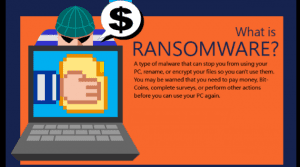 Ransomware is in the news continuously and is a growing problem.
Ransomware is in the news continuously and is a growing problem.
The Wannacry ransomware attacks of May 2017 raised the issue on a global level and demonstrated how easy it is for businesses and organisations to fall victim to it.
Please find below our brief guidance on Ransomware and what to do about it.
What is Ransomware?
Malicious software that locks a device, such as a computer, tablet or smartphone and then demands a ransom to unlock it
Where did Ransomware originate?
The first documented case appeared in 2005 in the United States, but quickly spread around the world.
How does it affect a computer?
The software is normally contained within an attachment to an email that masquerades as something innocent. Once opened it encrypts the hard drive, making it impossible to access or retrieve anything stored on there – such as photographs, documents or music
How can you protect yourself?
Anti-virus software can protect your machine, although cyber criminals are constantly working on new ways to override such protection. Further information is available on protection below.
How much are victims expected to pay?
The ransom demanded varies. Victims of a 2014 attack in the UK were charged £500. However, there’s no guarantee that paying will get your data back.
Read the latest Ransomware report from Datto here: 2017 Ransomware Report
Ransomware and what to do about it – prevention is better than cure
Most ransomware attacks are in fact quite simplistic from an IT perspective. They exploit vulnerabilities in operating systems where those operating systems haven’t been kept up to date with the latest security patches. Our recommendations are as follows:
- Train your staff on cyber hygiene – learn to recognise and avoid emails and websites that allow ransomware into your systems in the first place. Fresh Mango has training courses available for this purpose.
- Ensure all your IT systems are maintained up to date. If you still have software that is no longer supported (eg Windows XP) it’s time to upgrade
- Ensure you have a professional (not free) anti-virus solution in place
- Ensure your IT systems are backed-up professionally. Belt-and-braces is best – a Cloud backup and a separate hard-drive / server backup are strongly recommended. If you have this in place then any ransomware that does get through to your system can be disregarded. The computer can be wiped (including the virus) and restored from the most recent backup.
- Consider more robust cyber security for your business – find out more about our cyber solutions here.

